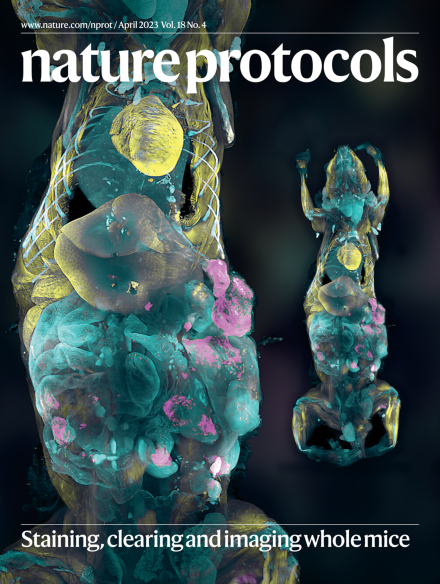利用 CRISPR-Cas9 基因组编辑技术快速生成同源荧光基因敲入人体细胞,并通过自动成像和数字 PCR 筛查进行验证。
IF 13.1
1区 生物学
Q1 BIOCHEMICAL RESEARCH METHODS
引用次数: 0
摘要
我们之前介绍了一种哺乳动物培养细胞基因组工程的方案,利用聚类规则间隔短回文重复序列和相关蛋白 9(CRISPR-Cas9)将荧光标签同源敲入内源基因。在此,我们更新了这一原方案,以反映工作流程在效率和通量方面的重大改进。简而言之,我们将优化 CRISPR-Cas9 试剂的高效电穿孔、通过自动明视野和荧光成像筛选单细胞克隆、使用数字聚合酶链式反应(PCR)快速评估标记等位基因和潜在非靶点的数量以及自动数据分析结合起来,改进了我们的方法。与原来的方案相比,我们目前的程序(1)大大提高了标签整合的效率;(2)自动识别来自单细胞的克隆,并正确定位标签蛋白的亚细胞位置;(3)提供了一种定量的高通量检测方法,利用数字聚合酶链反应测量靶上和脱靶整合的数量。新程序提高了效率,将需要深入分析的克隆数量减少了十倍以上,在一轮基因组工程中,多倍体癌细胞系中的同源克隆数量可达到 26% 以上。总之,在整个约 10 周的过程中,我们能够将动手时间从 30 天大幅缩短到 10 天,假定有经过验证的试剂(如 PCR 引物、数字 PCR 检测试剂和 Western 印迹抗体),一个人就能同时处理多达五个基因。本文章由计算机程序翻译,如有差异,请以英文原文为准。

Rapid generation of homozygous fluorescent knock-in human cells using CRISPR–Cas9 genome editing and validation by automated imaging and digital PCR screening
We previously described a protocol for genome engineering of mammalian cultured cells with clustered regularly interspaced short palindromic repeats and associated protein 9 (CRISPR–Cas9) to generate homozygous knock-ins of fluorescent tags into endogenous genes. Here we are updating this former protocol to reflect major improvements in the workflow regarding efficiency and throughput. In brief, we have improved our method by combining high-efficiency electroporation of optimized CRISPR–Cas9 reagents, screening of single cell-derived clones by automated bright-field and fluorescence imaging, rapidly assessing the number of tagged alleles and potential off-targets using digital polymerase chain reaction (PCR) and automated data analysis. Compared with the original protocol, our current procedure (1) substantially increases the efficiency of tag integration, (2) automates the identification of clones derived from single cells with correct subcellular localization of the tagged protein and (3) provides a quantitative and high throughput assay to measure the number of on- and off-target integrations with digital PCR. The increased efficiency of the new procedure reduces the number of clones that need to be analyzed in-depth by more than tenfold and yields to more than 26% of homozygous clones in polyploid cancer cell lines in a single genome engineering round. Overall, we were able to dramatically reduce the hands-on time from 30 d to 10 d during the overall ~10 week procedure, allowing a single person to process up to five genes in parallel, assuming that validated reagents—for example, PCR primers, digital PCR assays and western blot antibodies—are available. In this protocol update, the authors improve on their previous protocol for genome engineering of mammalian cultured cells with CRISPR–Cas9 to generate homozygous knock-ins of fluorescent tags into endogenous genes, to increase both efficiency and throughput.
求助全文
通过发布文献求助,成功后即可免费获取论文全文。
去求助
来源期刊

Nature Protocols
生物-生化研究方法
CiteScore
29.10
自引率
0.70%
发文量
128
审稿时长
4 months
期刊介绍:
Nature Protocols focuses on publishing protocols used to address significant biological and biomedical science research questions, including methods grounded in physics and chemistry with practical applications to biological problems. The journal caters to a primary audience of research scientists and, as such, exclusively publishes protocols with research applications. Protocols primarily aimed at influencing patient management and treatment decisions are not featured.
The specific techniques covered encompass a wide range, including but not limited to: Biochemistry, Cell biology, Cell culture, Chemical modification, Computational biology, Developmental biology, Epigenomics, Genetic analysis, Genetic modification, Genomics, Imaging, Immunology, Isolation, purification, and separation, Lipidomics, Metabolomics, Microbiology, Model organisms, Nanotechnology, Neuroscience, Nucleic-acid-based molecular biology, Pharmacology, Plant biology, Protein analysis, Proteomics, Spectroscopy, Structural biology, Synthetic chemistry, Tissue culture, Toxicology, and Virology.
 求助内容:
求助内容: 应助结果提醒方式:
应助结果提醒方式:


